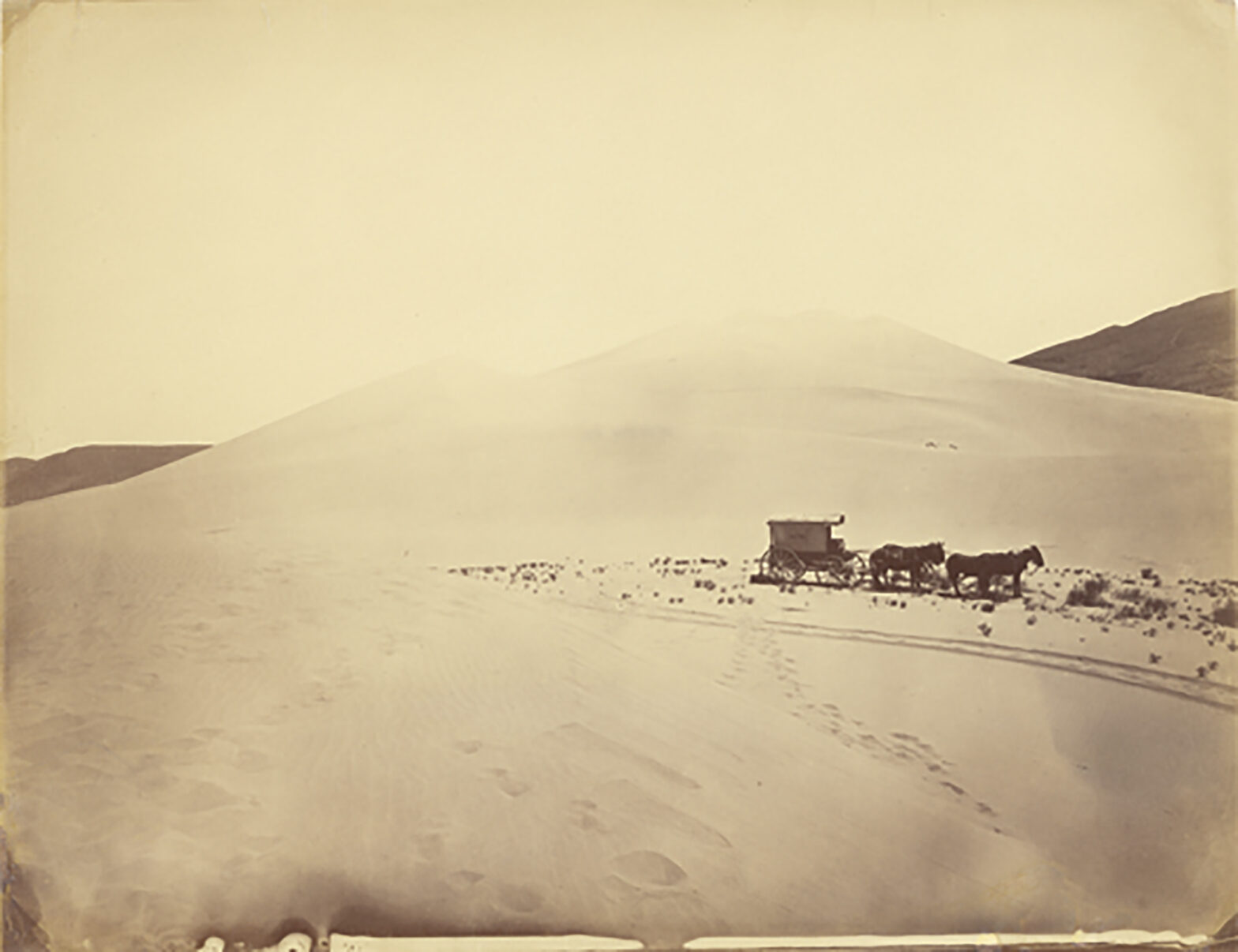Notes On James Benning’s Ten Skies
Seit der Erfindung der Fotografie stellt die Horizontlinie, die Trennung von Land und Himmel, ein sich wiederholendes, nicht nur technisches Hindernis für die fotografische Abbildung von Landschaft dar. Für Ray Klimek rekapitulieren die Horizontlinien in seinen Bemerkungen zu James Bennings Film Ten Skies die Geschichte der Fotografie. Gleichzeitig ziehen sie eine Grenze zwischen einem abstrakt-utopischen Raum und seinem nüchterneren irdischen Gegenpart.
1. James Benning’s Ten Skies employs a basic structure: ten skies, ten minutes per sky—each a stationary image, no camera movement, no voice over. Whatever happens, happens in the frame—the motion of clouds, of smoke, of light and shifting colors, the occasional bird. It’s potentially seductive, as meditative as the real thing. But there’s more—a soundtrack of various sounds and noises, an excess, that haunts and complicates anything too ethereal, that tugs at us, not quite pulling us back, but acting as a reminder of something, a guilty memory. The sound, in effect, reinstates the horizon in images, that otherwise verge on kinetic abstraction. And introduces politics into a potentially sealed off esthetic zone.
2. Benning’s skies have a history steeped in the particular dance of technics and light that characterized nineteenth century photography. The sky was a problem for early photographers. Inevitably at variance, the ground and sky in any landscape required different exposures. Expose for the ground and the sky became a washed out void; expose for the sky and the ground became a vast shadow. It’s a lesson beginners are still obliged to learn. The limitations of early film emulsions thus interfered with the ostensible realism of the image. The landscape on the photographic plate was half a landscape. In a few instances it resulted in some striking effects. The blown out skies of Timothy O’Sullivan for instance suggest a variant of the sublime, not so much threatening as blank and pitiless.
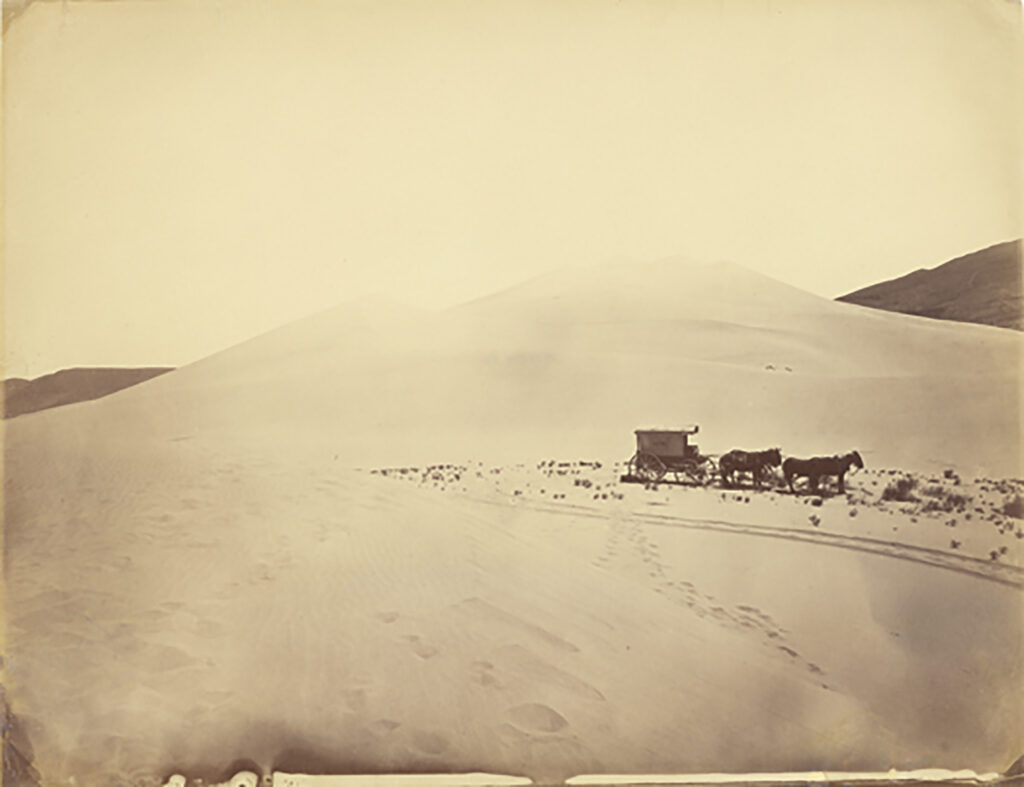
Desert Sand Hills near Sink of Carson, Nevada, 1867, Albumen silver print
22,2 x 29,2 cm
3. An early special effect sometimes came to the rescue. Combination prints allowed the photographer to create what appeared to be more realistic landscapes— suddenly clouds were supported by equally detailed grounds, harmonized to resemble actual scenes or at least the effects that had long been the province of the painted landscape. The discovery made it possible to displace individual elements of a landscape and to reassemble them in various combinations. Yet, even in instances that attempted to remain true to a particular scene, a discrepancy was inevitable. The fact that a photographer needed to make two images of the same scene meant that a temporal disjunction, an interval however minute, was built into the process. Theoretically, this would only be obvious in instances where light changed suddenly and dramatically, but in all instances it haunted the photo casting doubt on its claim to verisimilitude.
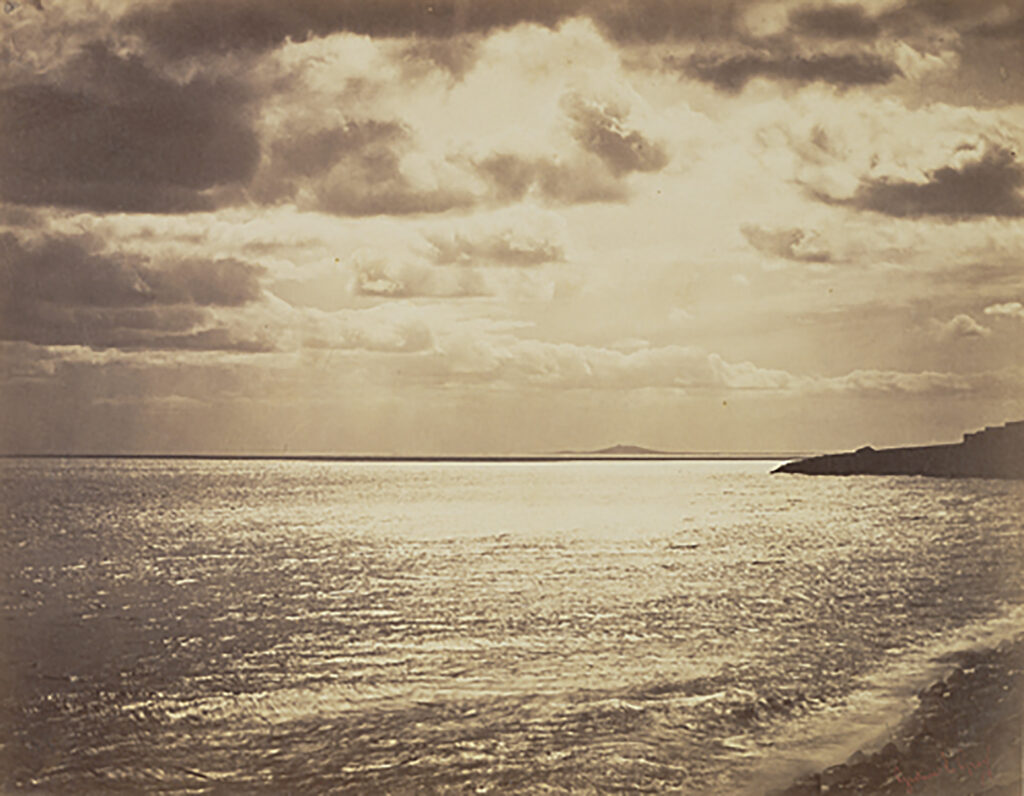
Mediterranean Sea, Sète, No. 18, 1857,
Albumen silver print
31,8 × 41,1 cm
4. The composite process is most obvious in a particularly dramatic sky that recurs in a number of Gustave Le Gray’s prints. An ephemeral phenomenon thus becomes part of a “standing reserve”, available for reuse in a variety of settings to create a calculated effect. Looking at Le Gray’s prints in sequence can be disconcerting, as though the clouds were somehow solid, stable and the ground a set of shifting scenes – a dizzying inversion, as though one had entered the looking glass world of another early photographer.

Equivalents, 1923,
Gelatin silver print (chloride)
9,2 × 11,8 cm
5. In his series Equivalents, Alfred Stieglitz sidestepped the sky/ground divide by simply pointing his camera upward. Stieglitz’s images are, at best, minimally grounded—virtually all sky with the occasional appearance of an earthly silhouette at the bottom of the frame. His sky is a theater of emotion, shut off from the concrete material world, except insofar as the latter provides a frame, a proscenium arch to set off the heavenly action. Even then, the focus is less upward than inward. According to Stieglitz, the varied skies of his series functioned as conveyers of fleeting emotions and shifting states of feeling—the motion of emotion cut off from the mundane mechanics of cause and effect. In essence, it was what Dylan Thomas called “a process in the weather of the heart.”
More importantly, Stieglitz accepts the separation that earlier photographers sought to overcome. The sky becomes a realm in its own right—a space of malleable forms without the freight of earthbound constraints. If the ground was strictly speaking materiality (which in early twentieth century America inevitably suggested the taint of commerce), the sky pointed to the fluidity and ideality of spirit. Although undertaken in Stieglitz’s straight phase, Equivalents bore the mark of his earlier pictorialism, especially in its focus on the shifting and the ephemeral—the clouds bearing a close relation to the smoke and haze of pictorial and symbolist aesthetics. Moreover, it pointed the way to pictorial abstraction, especially to the degree that abstraction had made a claim to spiritual transcendence in the work of various European modernists, whose work Stieglitz had championed. In particular, Kandinsky’s theories regarding the spiritual in art provided a direction and a framework for Stieglitz’s series. Against the claims and constraints of a sordid popular culture, abstraction promised greater freedom and flexibility, a defense against what Wallace Stevens called the “mickey mockers” of commercial culture in The American Sublime, the same culture Stieglitz had allegorized as a gelded horse in Spiritual America. Significantly, Stieglitz guarded the boundary between the parodic and the transcendental in his work. Denying materiality, however, ran the risk of elevating the subjective and the personal above the social to the degree that it undercuts its own critical potential. In short it pointed the way toward a self-contained formalism.
6. The eponymous figure in Baudelaire’s The Stranger, questioned about what he loves denies mother, father, sister, brother, gold and other earthly attachments, declaring his love of “the clouds … drifting by …”. In a later poem from Paris Spleen the narrator likewise praises, “those moving architectural marvels that God constructs out of mist, edifices of the impalpable,” a vision he relates to the eyes of his “mad little beloved”. And then the interruption—a “blow of a fist”, a voice, “husky … hysterical … hoarse”: “Aren’t you ever going to eat your soup, you damned bastard of a cloud monger?”.
It is as though the reverie were the province of the visual, of eyes whether of the lover or the beloved, of a vision either exterior or interior. And the daydream is silent. Framed by a window it resembles a film without a soundtrack. The voice commensurate with the fist is an interruption, a denial, and a reassertion of something resistant, earthly, and pragmatic—the return of the real in the voice of the world indistinguishable from the bourgeois imperative to “come back to earth”.
7. In other instances the sky serves as a blank slate, the romantic blue dome an instrument of forgetting. Klaus Kreimeier, writing about Harun Farocki’s Videograms of a Revolution notes:
“The last appearance of Nicolae Ceausescu on the balcony of the Central Committee is being recorded by state television; image and sound function well until the moment when an off-screen movement of the listening crowd takes place; this annoys the dictator whose speech falters. The transmission is interrupted, but because the outside-broadcasting van was still recording, there is material that partially capture the progress of events. The cameras point to the sky in accordance with the rules for disturbances during a live broadcast.”
The azure as erasure.
8. Pollution marks an unfortunate fusion of earth and sky. Visible air is tainted air, denigrated and dragged through the mud. Bruce Nauman’s L. A. Air depicts a grayish monotone, an initial abstraction undercut by a title that deliberately desublimates its subject. Nauman’s is a piece with a point, a color field made from the smog and pollution smudging the skies of Los Angeles, a return of the repressed in a one-liner that easily scores off abstract pretense. If Stieglitz’s skies pointed to abstraction as an alternative to material corruption, Nauman posits the base of that abstraction as already corrupt, inevitably joined to and mired by the workings of a commercial and industrial ground.
Robert Smithson’s Incidents of Mirror Travel moves in the opposite direction as it drags the sky into the mud and maintains a temporal simultaneity while introducing a spatial disparity. This time not marked by the horizon, but embedded in dirt, clay and mud. A collage. A marriage of elements that points back toward an original primal chaos.
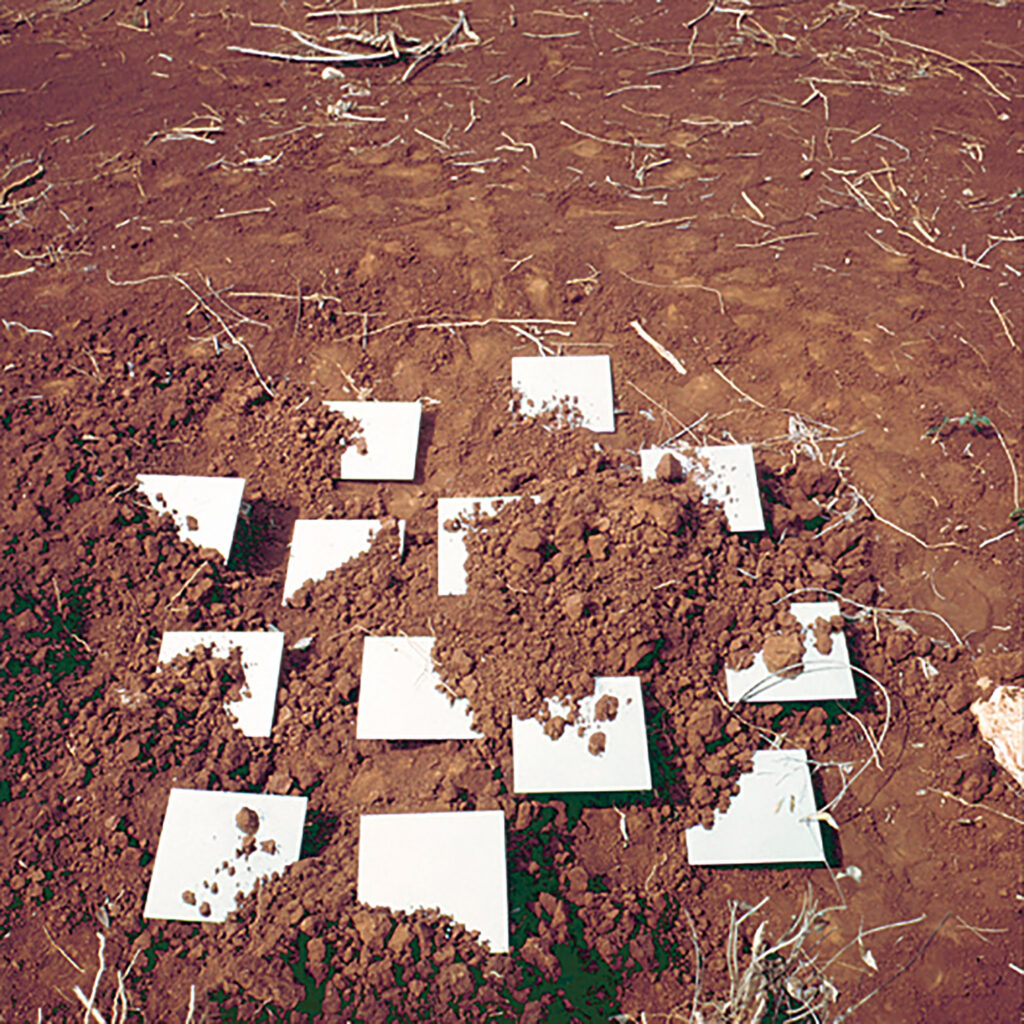
Mirror Displacements (Bramble), Sept 1969,
Chromogenic print from 35 mm slide
61 x 61 cm
9. Stieglitz’s Equivalents constitutes an early example of a landscape approach that became common in the latter part of the twentieth century. The approach entailed breaking down landscape imagery into its components. Several examples stand out in photography most famously Roni Horn’s focus on water in Dictionary of Water and The River Thames, for Instance. But Horn’s work also points beyond abstraction. In The River Thames, she appends a series of facts regarding the river, largely suicides, which bring its potentially abstract shapes back into a narrative and social field of references. On some level the desire to approach the series as a formal exercise, a desire that the images themselves foster, is undercut by the texts reminding us of a larger framework off-screen. Horn thus leaves behind the notion of a language of forms in favor of a complex unresolved relation between language and form.
A similar tension occurs in Richard Misrach’s sky series, part of the larger work, Desert Cantos. Unlike Stieglitz’s cloud covered images with their links to symbolist atmospherics, Misrach’s skies are reminiscent of color field paintings, at their most minimal reduced to monochrome surfaces. Like Horn, however, Misrach locates the images within a more earthbound framework of dates, times and locations effectively anchoring them with documentary details. He thus returns the viewer from an initial sense of transcendence to the mundane realm of concrete facts. As Rebecca Solnit, Misrach’s most sympathetic critic, has written: “The titles on Richard Misrach’s celestial photographs ask you to come back to earth, tugging against the boundless sublimity the visual matter itself offers tethering it to earthly problems of meaning and political history”. Yet, the relation between word and image, as Solnit argues elsewhere, is less a resolution than an overlay. Even as the words suggest the disruptive voice of Baudelaire’s Paris Spleen, the image is apt to respond “Nevertheless …”.
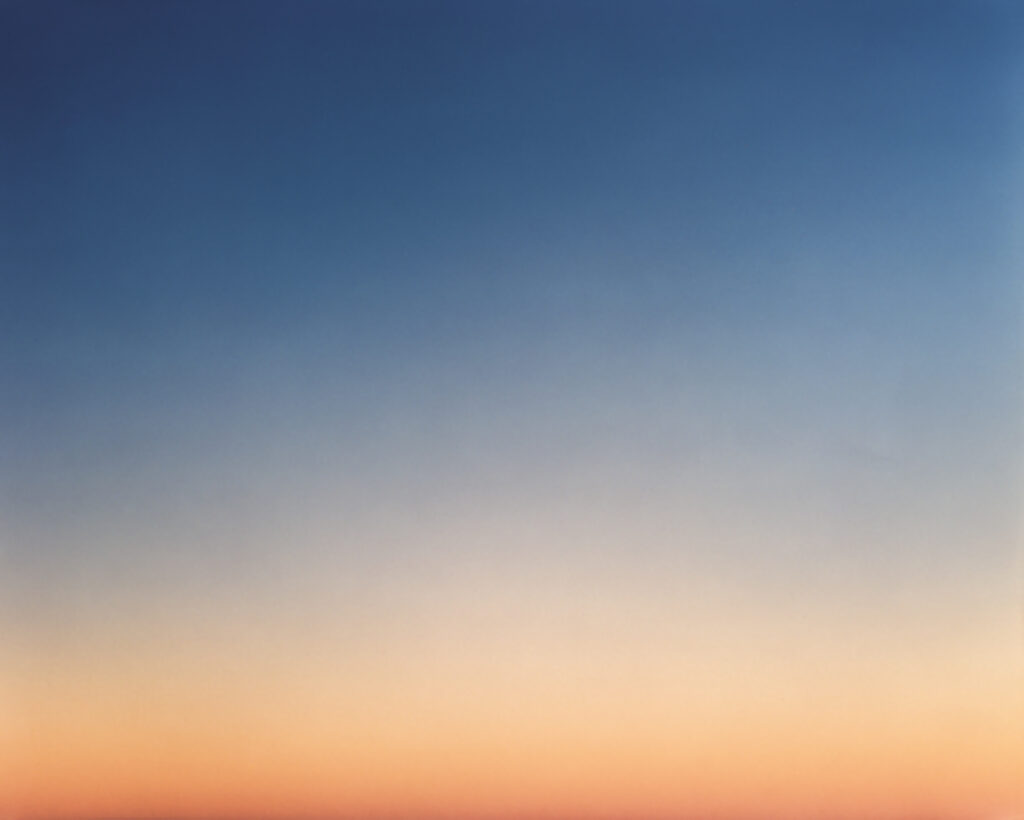
Massacre Dry Lake, California, 3.10.97
6:48 pm, 1997, Chromogenic print
121,9 × 152,4 cm
10. Benning’s Ten Skies sets the sky in motion in a way that harks back to the Lumière brothers, appealing to the residual pleasures of early cinephilia—the fascination with motion, the celebration of the wind in the trees that a number of critics have cited as an early example of cinematic appreciation. Like Stieglitz and Misrach, Benning puts the sky center stage, but adds an extra temporal dimension to the mix in the form of both sound and motion.
In an interview with Scott MacDonald, Benning observed, “The look of the sky was a function of the land below”. The obvious example is a shot of smoke from a forest fire rising into the frame from the bottom of the screen, thus tying the sky to the earth below. But for the most part the land is represented here as a series of sounds: gunshots and traffic, crickets and barking dogs, birds and helicopters and a variety of other less identifiable noises. Benning further emphasizes the disparity of earth and sky by introducing non-diegetic elements into the aural mix. Ten Skies was filmed in Val Verde, California, yet its soundtrack, according to Benning, consists of elements borrowed from some of his previous films, thus creating a further temporal disjunction. In essence, the soundtrack, in conjunction with the images, delineates a virtual horizon that simultaneously welds together and separates earth and sky, past and present.
The visual elements of the film along with their disconcerting aural accompaniment recall both the visual pleasures of silent cinema and the anxiety of early cinephiles regarding its inevitable capitulation to sound. In his seminal Film as Art, Rudolf Arnheim argued, “silent film derives definite artistic potentialities from its silence”. The statement is of a piece with Arnheim’s general tendency to define any art in terms of its limitations, a stance inherited from Lessing and congenial to a number of later modernist critics. The use of sound reenacts an early complaint to the effect that the introduction of sound destroyed the aura of the silent cinema, compromising its air of fantasy with the impertinence of reality. Both an omnidirectional and an involuntary sense, hearing is more promiscuous and more vulnerable. It admits more chance encounters. It lets more in.
11. “There is a crack in everything / That’s how the light gets in” sings Leonard Cohen, one of Benning’s favorite performers. The cinematic structure and meaning of Ten Skies depends on that crack, which can be conceived as the film’s unseen yet implicit horizon line. The film offers up a sense of beauty haunted by a flaw, a beauty out of sync with a disruptive aural and implicitly political background that stubbornly refuses to be left behind. At the same time the beauty itself is somehow heightened by and dependent on the disparity between its utopian promise and its actual position in a dystopian life world. Benning’s refusal to either harmonize the two or to privilege one over the other signals a complexity opposed to simple esthetic and political nostrums. The space between elements becomes a space for both analysis and reverie.
Erstmals erschienen in der Herbstausgabe 2014 des Raritan Quarterly.
